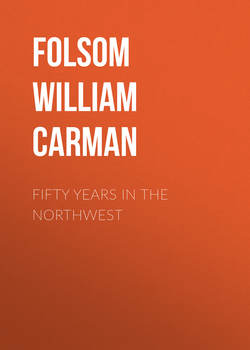Читать книгу Fifty Years In The Northwest - Folsom William Henry Carman - Страница 82
CHAPTER VI.
ST. CROIX COUNTY
HUDSON CITY
ОглавлениеThe first settlement in St. Croix county was made on the present site of Hudson city in 1838 by Peter Bouchea, Louis Massey, Wm. Steets and Joseph Lagroo, Frenchmen, who subsisted chiefly by hunting and fishing, but who also raised garden crops of corn, beans and other vegetables. These people were contented and jovial, fond of dancing and social enjoyment. Beyond the mere pleasure of living they seemed to have but little care and were without enterprise or ambition. More enterprising and industrious people followed them to the new settlement, and as the public lands were not open for entry until 1848, settled upon the lands and made some improvements, awaiting patiently the time when they could acquire a legal title. The original claimants of the town of Buena Vista in 1848 were Peter Bouchea, Louis Massey, Wm. Steets, Joseph Lagroo, Joseph Lenavil, – Revere, Ammah Andrews, W. H. and M. V. Nobles, John B. Page, Philip Aldrich, and W. R. Anderson. These parties, after the survey and prior to the entry of the land, made an equitable division of their claims. Peter Bouchea and Louis Massey were then delegated to purchase the lands, which they did, Bouchea purchasing the southwest quarter of southeast quarter of section 24, township 29, range 20, and Massey, the northwest quarter of the southeast quarter of section 24, township 29, range 20. Deeds were then made to the various claimants according to the original agreement. The first individual survey of lots was made on Massey's entry, Harvey Wilson, of Stillwater, being the surveyor. The village thus platted was at first called Buena Vista, but some confusion arising as to the title of lots in 1851, the legislature changed the name of the town and village to Willow River, which, by vote of the people in 1852, was changed to Hudson. The original proprietors of the village of Buena Vista were Paschal Aldrich, James Sanders, Moses Perin, James R. Patten and Joseph Abear. Additions were surveyed in 1849 and 1850 by Gibson, Henning and others. To avoid confusion we shall discard the earlier names applied to what has since become the city of Hudson and speak of it solely by its later and better known name.
In 1840 the locality, as seen from a passing steamer, seemed a wilderness of orchard oaks and maples, filling the valley of Willow river, and clothing the slopes of the hills. A closer view might have revealed an occasional shanty, a cabin of the first French settlers, with small gardens, the whole inclosed by high picket fences as a protection against strolling Indians. Seven years later loggers were at work on Willow river under Capt. J. B. Page. The same year a couple of frame houses appeared in the oak openings. The first was built by W. H. Nobles, which is still standing and is occupied by Mrs. Col. James Hughes. The second was built by Ammah Andrews and is now occupied by Horace Champlin. In 1848 James Purinton commenced a saw mill and dam at the mouth of Willow river, which were not, completed until 1850. In 1848 Wm. H. Nobles started a ferry over the lake. James Purinton opened a store and Moses Perin built a hotel and boarding house, which stood opposite Champlin's present livery stable. In 1849 Miss Richards, from Prairie du Chien, taught the first school. Mrs. A. M. Richardson, the wife of the Methodist minister, the second. A school house was not built until 1855. John G. Putman built the Buckeye House, corner of First and Buckeye streets. Horace Barlow built a residence. Mr. Stone also put up a store building. The first attorneys, Daniel Noble Johnson and Col. James Hughes, commenced practice in Hudson in 1849. The first public building stood on the lot now occupied by the Methodist church. It burned down in the spring of 1851, and an account of the fire, as published at that time, stated that the "court house, Methodist, Baptist, Congregational and Episcopal churches, together with the high school buildings, were all consumed." It is but fair to say that there were no regular church organizations at this time, but occasional services by local and transient ministers. Rev. Lemuel Nobles, a Methodist minister, preached the first sermon in 1847. The first society organization was that of the Baptists, Rev. S. T. Catlin, pastor, in 1852. In the same year Rev. A. M. Richardson was regularly appointed as pastor of the Methodist Episcopal church. In 1855 the First Presbyterian church was organized under the pastorate of Rev. Chas. Thayer, and Rev. Wilcoxson became the first rector of the Episcopal church. In 1856 Rev. Father McGee took charge of the Catholic church. In 1857 Rev. C. H. Marshall was called to the pastorate of the Congregational church. A Norwegian Lutheran church was organized in 1876. All of these church organizations have good church buildings, and the Catholic church has a flourishing school connected with it. School interests were not neglected by the early settlers. A good school house was built in 1855 and graded. The first deed recorded covering Hudson property was by Louis Massey and Frances, his wife, to Wm. H. Nobles; warranty; consideration, $67.18; situate in east half of southwest quarter of section 24, township 29, range 20.
